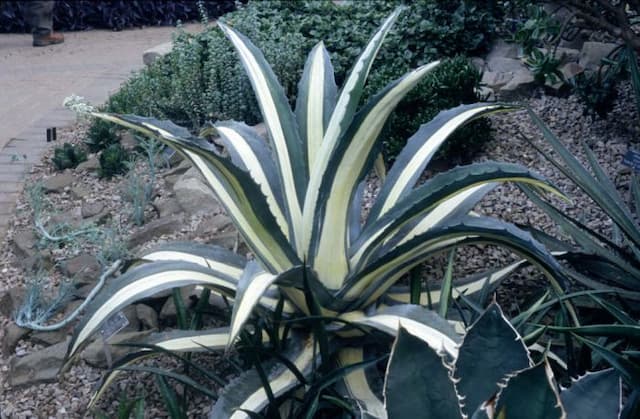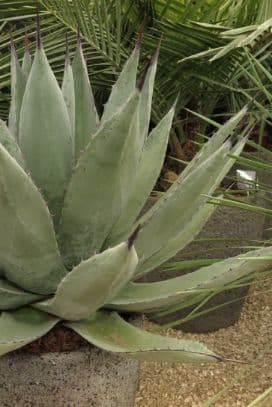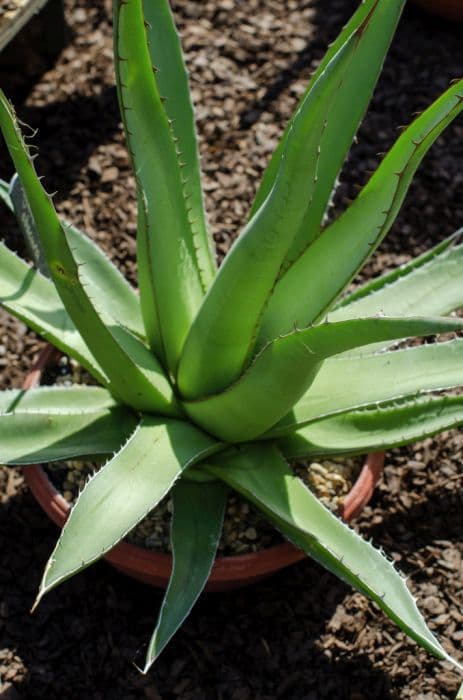White camas Camassia leichtlinii subsp. suksdorfii 'Alba'

ABOUT
The plant, commonly known as the white camas, showcases elegant, star-shaped white flowers that form in loose, elongated clusters atop slender stems. These flowers have a distinctive charm, each petal gently curving upwards, converging at their tips to create an alluring cup-like form. Giving off a subtle sweet fragrance, these blossoms are a serene presence in any garden. The foliage is composed of long, slender leaves that gracefully arch out and around the base of the stem in a lush green rosette, providing a beautiful contrast to the purity of the white blooms above. The overall shape of the plant is upright and linear, with an orderly and uncluttered aspect that allows it to blend harmoniously into both formal and informal landscapes.
About this plant
 Names
NamesFamily
Asparagaceae.
Synonyms
Large Camas, White Camas, Suksdorf's Camas, Quamash.
Common names
Camassia suksdorfii 'Alba', Camassia leichtlinii var. suksdorfii 'Alba'.
 Toxicity
ToxicityTo humans
Great Camas, in its wild form, is known historically as a food source for various indigenous peoples of North America, who would traditionally cook the bulbs to neutralize any harmful constituents. However, it is important to note that the bulbs of the Great Camas can be toxic if eaten raw. Raw bulbs contain compounds that can lead to gastrointestinal discomfort and illness. Proper identification and preparation are necessary to avoid the intake of a similar-looking toxic plant known as death camas. Symptoms of poisoning by Great Camas consumed raw or improperly prepared can include nausea, vomiting, abdominal pain, and diarrhea.
To pets
The Great Camas is not commonly listed as a toxic plant for domestic animals such as dogs and cats. Nonetheless, ingestion by pets may potentially lead to mild gastrointestinal upset due to the novelty and fibrous nature of the plant material. As with humans, consuming the plant in large quantities or in its raw form may result in more pronounced symptoms of gastrointestinal distress such as vomiting or diarrhea. It is generally advisable to prevent pets from consuming non-food plants as individual sensitivities can vary widely.
 Characteristics
CharacteristicsLife cycle
Perennials
Foliage type
Deciduous
Color of leaves
Green
Flower color
White
Height
2-3 feet (60-90 cm)
Spread
1-2 feet (30-60 cm)
Plant type
Bulb
Hardiness zones
4-8
Native area
North America
Benefits
 General Benefits
General Benefits- Attracts Pollinators: The flowers of Camassia leichtlinii subsp. suksdorfii 'Alba', also known as large camas, offer nectar and pollen that attract bees, butterflies, and other beneficial insects.
- Aesthetic Appeal: With its striking white flowers, large camas adds elegance and a splash of brightness to gardens and landscapes.
- Low Maintenance: Once established, large camas requires minimal care, making it a suitable choice for gardeners seeking low-maintenance plant options.
- Tolerates Wet Soil: Large camas is naturally adapted to moist conditions and can thrive in areas where other plants might struggle due to wet soil.
- Naturalizing: Over time, large camas can spread and naturalize in an area, creating a charming and seemingly wild appearance in gardens and meadows.
- Wildlife Habitat: It provides a habitat for various wildlife species, either as a source of food or as a protective environment among its foliage.
- Seasonal Interest: The blooming period of large camas in spring offers a seasonal interest, enlivening gardens at a time when many other plants have yet to flourish.
- Drought Tolerance: Once established, large camas is quite drought-tolerant, reducing the need for frequent watering during dry periods.
- Erosion Control: The root system of large camas can help to stabilize soil and prevent erosion on slopes or in areas with loose soil.
- Culinary History: While not a direct garden benefit, large camas has a rich cultural history with many Indigenous peoples of North America, who have traditionally valued it as a food source.
 Medical Properties
Medical PropertiesThis plant is not used for medical purposes.
 Air-purifying Qualities
Air-purifying QualitiesThis plant is not specifically known for air purifying qualities.
 Other Uses
Other Uses- Great Camas bulbs were once used by Indigenous peoples as a food source after careful cooking or pit roasting to break down inulin into fructose.
- The bulbs can be crushed to make a type of glue or adhesive in survival situations.
- Great Camas flowers are suitable for cut flower arrangements and can hold well in vases.
- Dried seed pods from Great Camas can add interesting texture and visual appeal to dried floral arrangements.
- The plant can be used as a natural dye source; different parts yield different colors.
- Great Camas acts as a natural attractant for beneficial insects, like bees and butterflies, thus supporting local ecosystems.
- When planted in large numbers, the plant can create a meadow effect, which can be used in natural landscaping or restoration projects.
- The plant's ability to grow in wet areas makes it useful for rain gardens or areas with poor drainage.
- Great Camas can be used in educational settings to teach about native plants and their historical significance to indigenous cultures.
- Seed harvesting from Great Camas provides opportunities to cultivate and spread the plant, thus conserving a species with diminishing habitats.
Interesting Facts
 Feng Shui
Feng ShuiThe plant Camassia is not used in Feng Shui practice.
 Zodiac Sign Compitability
Zodiac Sign CompitabilityThe plant Camassia is not used in astrology practice.
 Plant Symbolism
Plant Symbolism- Persistence: The 'Alba' variety of Camassia, commonly known as White Camas, is known for its resilience and ability to grow in tough conditions, symbolizing persistence and the capacity to thrive against odds.
- Purity: With its pure white blossoms, White Camas often represents cleanliness, innocence, and purity, commonly seen in various cultural ceremonies and traditions.
- Peace: The color white is universally associated with peace and tranquility, and thus, White Camas can be used to represent a desire for harmony and calmness.
- Transformation: Camassia species have a natural progression from bulb to striking flower, symbolizing transformation and the beauty of change in life's cycles.
 Water
WaterFor the White Camas, it is best to water moderately during its growing season, which is usually spring to early summer. Aim to keep the soil consistently moist but not waterlogged, as excessive moisture can lead to bulb rot. Depending on the temperature and rainfall, this may equate to about 1 inch of water weekly. During dormancy, after the foliage has died back, reduce watering significantly. Ensure proper drainage in the planting area to avoid standing water around the bulbs.
 Light
LightThe White Camas thrives in full sunlight to partial shade. It prefers a location that receives at least six hours of sunlight daily. However, in hotter climates, some afternoon shade can be beneficial to prevent scorching of the leaves. An ideal spot would be one where morning sun is abundant and light shade protects the plant during the intense heat of the afternoon.
 Temperature
TemperatureWhite Camas is best suited to USDA zones 4 through 8 and can handle temperatures from -30°F to 90°F. However, its ideal growth temperature ranges between 60°F and 75°F. It's a hardy plant that can survive winter chills and moderate summer heat, but prolonged exposure to temperatures beyond its comfort zone may impact flowering and growth.
 Pruning
PruningPruning White Camas involves deadheading the spent flowers after blooming to prevent seed formation and encourage the plant to focus energy on bulb strength. Cut back the stems to the base once the leaves have yellowed and withered, typically in late summer. This annual tidy-up helps maintain plant health and may enhance blooming performance the following season.
 Cleaning
CleaningAs needed
 Soil
SoilLarge Camas or 'Alba' thrives best in a soil mix that is rich in organic matter, well-draining yet retains moisture, with a pH ranging from 6.0 to 7.0 (slightly acidic to neutral). A blend of loamy garden soil, compost, and a bit of sand for drainage would provide an optimal growing medium.
 Repotting
RepottingThe Large Camas should be repotted only when it has outgrown its current container, which is typically every 2 to 3 years. It's important to do this in late summer after the foliage has died back.
 Humidity & Misting
Humidity & MistingLarge Camas prefers moderate humidity levels, similar to what it would experience in its native habitat, around 40-60%. Consistent humidity without being overly wet is key to its health.
 Suitable locations
Suitable locationsIndoor
Large Camas requires bright, indirect light indoors and cool temperatures.
Outdoor
Plant in partial sun, moist soil, and provide winter mulch in colder zones.
Hardiness zone
4-8 USDA
 Life cycle
Life cycleThe life cycle of Camassia leichtlinii subsp. suksdorfii 'Alba', commonly known as White Camas, begins with the germination of seeds in late winter or early spring, in moist but well-drained soil. The plant develops a basal rosette of linear leaves as temperatures increase. By late spring to early summer, White Camas sends up tall flower spikes bearing star-shaped white flowers that attract pollinators such as bees and butterflies. After flowering, the plant sets seed which will eventually fall to the ground and can lie dormant until the next appropriate germination period. During late summer, the foliage begins to yellow and die back as the plant enters a period of dormancy. The bulbous roots of White Camas persist underground, storing energy to initiate the next lifecycle when conditions are again favorable.
 Propogation
PropogationPropogation time
Spring to Summer
Camassia leichtlinii subsp. suksdorfii 'Alba', commonly known as White Camas, is typically propagated by division, a process best carried out in autumn after the foliage has died back or in early spring before new growth begins. To propagate by division, carefully dig up the clumps of bulbs, ensuring minimal damage to the bulbs and roots. Gently separate the bulbs by hand, each section having at least one growth point or shoot. Replant the divided bulbs immediately at a depth of about 3 to 4 inches (7.5 to 10 cm), and space them approximately 6 to 8 inches (15 to 20 cm) apart to allow adequate room for growth. Water them well after replanting to settle the soil around the bulbs and help them establish.









